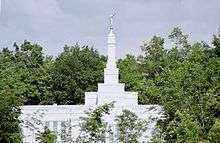Palmyra New York Temple
| Palmyra New York Temple | |||||||||||||||||||||||||||||||||||||||||
|---|---|---|---|---|---|---|---|---|---|---|---|---|---|---|---|---|---|---|---|---|---|---|---|---|---|---|---|---|---|---|---|---|---|---|---|---|---|---|---|---|---|
 Palmyra Temple as seen from the Sacred Grove | |||||||||||||||||||||||||||||||||||||||||
| Number | 77 | ||||||||||||||||||||||||||||||||||||||||
| Dedicated | April 6, 2000 by Gordon B. Hinckley | ||||||||||||||||||||||||||||||||||||||||
| Site | 5 acres (2 hectares) | ||||||||||||||||||||||||||||||||||||||||
| Floor area | 10,700 sq ft (990 m2) | ||||||||||||||||||||||||||||||||||||||||
| Height | 71 ft (22 m) | ||||||||||||||||||||||||||||||||||||||||
| Preceded by | Louisville Kentucky Temple | ||||||||||||||||||||||||||||||||||||||||
| Followed by | Fresno California Temple | ||||||||||||||||||||||||||||||||||||||||
| Official website • News & images | |||||||||||||||||||||||||||||||||||||||||
| |||||||||||||||||||||||||||||||||||||||||
Coordinates: 43°2′20.09039″N 77°14′12.80040″W / 43.0389139972°N 77.2368890000°W The Palmyra New York Temple is the 77th operating temple of the Church of Jesus Christ of Latter-day Saints (LDS Church).
The site for the Palmyra New York Temple, atop a wooded hill in pastoral western New York, is in an area prominent in the early history of the Latter Day Saint movement. Nearby is the grove of trees known as the Sacred Grove in which the founder and first prophet of the church, Joseph Smith, reported having a vision in which he saw God the Father and Jesus Christ, an event known as the First Vision. The temple grounds, on the border between the towns of Manchester and Palmyra, are also on the grounds of the original Smith Family Farm. The church itself was organized thirty miles away in Fayette, New York in 1830.
At the groundbreaking ceremony, held May 25, 1999, LDS Church president Gordon B. Hinckley commented on the area's rich history, saying that it was in that locale that Mormonism truly began. Hinckley also marveled at how much the church had grown since its founding in 1830.
Local reaction to the new temple was positive[1] and more than 30,700 visitors toured the new temple before its dedication. The temple serves about 18,000 members within seven stakes. The Palmyra New York Temple was dedicated on April 6, 2000, the 170th anniversary of the organization of the church. While only about 1,200 members attended the dedicatory sessions within the temple itself nearly 1.5 million members took part through media broadcasts throughout the United States and Canada.
The Palmyra New York Temple has a total of 10,700 square feet (990 m2), two ordinance rooms, and two sealing rooms. The exterior is white marble. Forty art glass windows inside the temple depict local events in LDS Church history. A gold statue of the angel Moroni tops the single spire. Ornate carved cherry wood railings, wainscoting, and moldings line the halls, along with hand-sculpted carpeting.
See also
Notes
- ↑ Stahle, Shaun (April 1, 2000), "Community interest reflects enthusiasm for Palmyra temple", Church News
References
- "Cover story: 100th temple announced; site in historic Palmyra area", Church News, February 20, 1999
- "Ground broken for Palmyra Temple, will overlook Sacred Grove", Church News, May 29, 1999
- "Six temple dates announced", Church News, February 12, 2000
- "Palmyra temple dedication to be seen on grand scale", Church News, March 18, 2000
- Condren, Dave (March 27, 2000), "New Temple Marks Origin of Mormons", Buffalo News, p. B1
- Moore, Carrie A. (April 6, 2000), "Web extra: LDS temple dedicated", Deseret News
- "Palmyra broadcast has reception bugs", Deseret News, April 7, 2000
- "Palmyra temple dedicated", Church News, April 8, 2000
- "A day of sacred significance", Church News, April 15, 2000
- "'Who could have imagined?': Maturing of the Church in land of Restoration", Church News, April 15, 2000
- "Sacred Grove, Sacred Light", Ensign, April 2002
- Sowby, Laurie Williams (July 10, 2010), "Visiting Palmyra, birthplace of the Restoration", Church News
- Nelson, Veneese C. (2002). "The Palmyra Temple: a significant link to LDS Church history". In Baugh, Alexander L.; Hedges, Andrew H. Regional studies in Latter-day Saint Church history: New York-Pennsylvania. Provo, Utah: Dept. of Church History and Doctrine, Brigham Young University. ISBN 0842525378. OCLC 52078417.
External links
- Official Palmyra New York Temple page
- Information about LDS Temples in New York
- Palmyra New York Temple page
